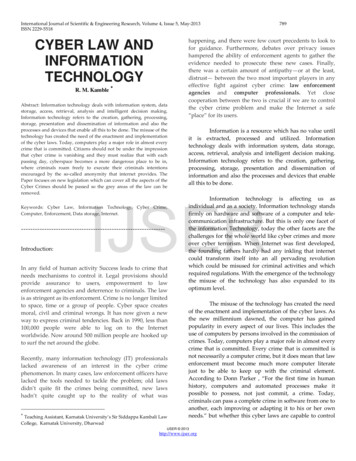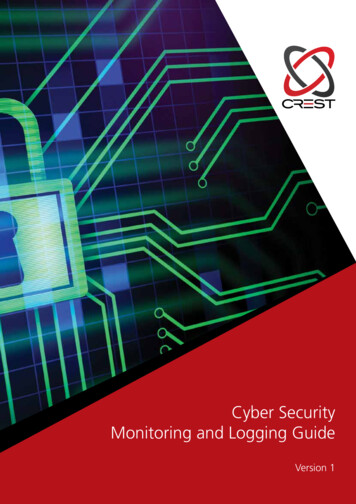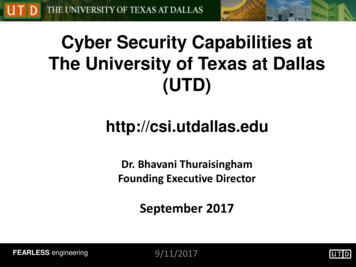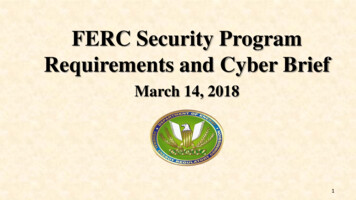
Transcription
International Journal of Scientific & Engineering Research, Volume 4, Issue 5, May-2013ISSN 2229-5518CYBER LAW ANDINFORMATIONTECHNOLOGYR. M. Kamble Abstract: Information technology deals with information system, datastorage, access, retrieval, analysis and intelligent decision making.Information technology refers to the creation, gathering, processing,storage, presentation and dissemination of information and also theprocesses and devices that enable all this to be done. The misuse of thetechnology has created the need of the enactment and implementationof the cyber laws. Today, computers play a major role in almost everycrime that is committed. Citizens should not be under the impressionthat cyber crime is vanishing and they must realize that with eachpassing day, cyberspace becomes a more dangerous place to be in,where criminals roam freely to execute their criminals intentionsencouraged by the so-called anonymity that internet provides. ThePaper focuses on new legislation which can cover all the aspects of theCyber Crimes should be passed so the grey areas of the law can ----------------------In any field of human activity Success leads to crime thatneeds mechanisms to control it. Legal provisions shouldprovide assurance to users, empowerment to lawenforcement agencies and deterrence to criminals. The lawis as stringent as its enforcement. Crime is no longer limitedto space, time or a group of people. Cyber space createsmoral, civil and criminal wrongs. It has now given a newway to express criminal tendencies. Back in 1990, less than100,000 people were able to log on to the Internetworldwide. Now around 500 million people are hooked upto surf the net around the globe.Recently, many information technology (IT) professionalslacked awareness of an interest in the cyber crimephenomenon. In many cases, law enforcement officers havelacked the tools needed to tackle the problem; old lawsdidn’t quite fit the crimes being committed, new lawshadn’t quite caught up to the reality of what was happening, and there were few court precedents to look tofor guidance. Furthermore, debates over privacy issueshampered the ability of enforcement agents to gather theevidence needed to prosecute these new cases. Finally,there was a certain amount of antipathy—or at the least,distrust— between the two most important players in anyeffective fight against cyber crime: law enforcementagencies and computer professionals. Yet closecooperation between the two is crucial if we are to controlthe cyber crime problem and make the Internet a safe“place” for its users.Information is a resource which has no value untilit is extracted, processed and utilized. Informationtechnology deals with information system, data storage,access, retrieval, analysis and intelligent decision making.Information technology refers to the creation, gathering,processing, storage, presentation and dissemination ofinformation and also the processes and devices that enableall this to be done.IJSERKeywords: Cyber Law, Information Technology, Cyber Crime,Computer, Enforcement, Data storage, Internet.Introduction:789Teaching Assistant, Karnatak University’s Sir Siddappa Kambali LawCollege, Karnatak University, DharwadInformation technology is affecting us asindividual and as a society. Information technology standsfirmly on hardware and software of a computer and telecommunication infrastructure. But this is only one facet ofthe information Technology, today the other facets are thechallenges for the whole world like cyber crimes and moreover cyber terrorism. When Internet was first developed,the founding fathers hardly had any inkling that internetcould transform itself into an all pervading revolutionwhich could be misused for criminal activities and whichrequired regulations. With the emergence of the technologythe misuse of the technology has also expanded to itsoptimum level.The misuse of the technology has created the needof the enactment and implementation of the cyber laws. Asthe new millennium dawned, the computer has gainedpopularity in every aspect of our lives. This includes theuse of computers by persons involved in the commission ofcrimes. Today, computers play a major role in almost everycrime that is committed. Every crime that is committed isnot necessarily a computer crime, but it does mean that lawenforcement must become much more computer literatejust to be able to keep up with the criminal element.According to Donn Parker , “For the first time in humanhistory, computers and automated processes make itpossible to possess, not just commit, a crime. Today,criminals can pass a complete crime in software from one toanother, each improving or adapting it to his or her ownneeds.” but whether this cyber laws are capable to controlIJSER 2013http://www.ijser.org
International Journal of Scientific & Engineering Research, Volume 4, Issue 5, May-2013ISSN 2229-5518the cyber crime activities, the question requires the at mostattention.Until recently, many information technology (IT)professionals lacked awareness of and interest in the cybercrime phenomenon. In many cases, law enforcementofficers have lacked the tools needed to tackle the problem;old laws didn’t quite fit the crimes being committed, newlaws hadn’t quite caught up to the reality of what washappening, and there were few court precedents to look tofor guidance. Furthermore, debates over privacy issueshampered the ability of enforcement agents to gather theevidence needed to prosecute these new cases. Finally,there was a certain amount of antipathy—or at the least,distrust— between the two most important players in anyeffective fight against cyber crime: law enforcementagencies and computer professionals. Yet closecooperation between the two is crucial if we are to controlthe cyber crime problem and make the Internet a safe“place” for its users.790as email spoofing and cyber defamation, sendingthreatening emails etc. A simple yet sturdy definition ofcyber crime would be "unlawful acts wherein the computeris either a tool or a target or both".In generally the term cybercrime was analyzed intotwo categories and defined thus:a. Cybercrime in a narrow sense (computer crime): Anyillegal behavior directed by means of electronic operationsthat targets the security of computer systems and the dataprocessed by them.b. Cybercrime in a broader sense (computer-related crime):Any illegal behavior committed by means of, or in relationto, a computer system or network, including such crimes asillegal possession [and] offering or distributing informationby means of a computer system or network.Of course, these definitions are complicated by thefact that an act may be illegal in one nation but not inanother.There are more concrete examples, includingi. Unauthorized accessii. Damage to computer data or programsiii. Computer sabotageiv. Unauthorized interception of communicationsv. Computer espionageIJSERLaw enforcement personnel understand thecriminal mindset and know the basics of gatheringevidence and bringing offenders to justice. IT personnelunderstand computers and networks, how they work, andhow to track down information on them. Each has half ofthe key to defeating the cyber criminal. IT professionalsneed good definitions of cyber crime in order to knowwhen (and what) to report to police, but law enforcementagencies must have statutory definitions of specific crimesin order to charge a criminal with an offense. The first stepin specifically defining individual cyber crimes is to sort allthe acts that can be considered cyber crimes into organizedcategories.What is a Computer Crime?a. Criminals Can Operate Anonymously Over theComputer Networks.b. Hackers Invade Privacy.c. Hackers Destroy "Property" in the Form of ComputerFiles or Records.d. Hackers Injure Other Computer Users by DestroyingInformation Systems.e. Computer Pirates Steal Intellectual Property.Definition of Cyber CrimeDefining cyber crimes, as "acts that are punishableby the Information Technology Act" would be unsuitable asthe Indian Penal Code also covers many cyber crimes, suchThese definitions, although not completelydefinitive, do give us a good starting point—one that hassome international recognition and agreement—fordetermining just what we mean by the term cybercrime.Classification of Cyber Crimes: The Information TechnologyAct deals with the following cyber crimes along with others:o Tampering with computer source documentso Hackingo Publishing of information, which is obscene in electronicformo Child Pornographyo Accessing protected systemo Breach of confidentiality and privacyCyber crimes other than those mentioned under the ITActo Cyber Stalkingo Cyber squattingo Data Diddlingo Cyber DefamationIJSER 2013http://www.ijser.org
International Journal of Scientific & Engineering Research, Volume 4, Issue 5, May-2013ISSN 2229-5518o Trojan Attacko Forgeryo Financial crimeso Internet time thefto Virus/worm attacko E-mail spoofingo Email bombingo Salami attacko Web Jackingchanges of 2004 was the waning influence of the boyhackers keen to make a name by writing a fast-spreadingvirus. Although teenage virus writers will still play aroundwith malicious code, 2004 saw a significant rise in criminaluse of malicious programs. The financial incentives weredriving criminal use of technology.Cyber law and TerrorismCyber crime and cyber terrorism are both crimes ofthe cyber world. The difference between the two however iswith regard to the motive and the intention of theperpetrator.While a cyber crime can be described simply as anunlawful act wherein the computer is either a tool or atarget or both, cyber terrorism deserves a more detaileddefinition. One can define cyber terrorism as apremeditated use of disruptive activities or the threatthereof, in cyber space, with the intention to further social,ideological, religious, political or similar objectives, or tointimidate any person in furtherance of such objectives.Cyber offenders:791Another reason for the increase in number of teenageoffenders in cyber crimes are that many of the offenderswho are mainly young college students are unaware of itsseriousness. Recently the Chennai city police have arrestedan engineering college student from Tamil Nadu forsending unsolicited message to a chartered accountant. Theboy is now released on bail. So counseling session forcollege students has to be launched to educate them on thegravity and consequences emanating from such crimes.In September, 2005, A Massachusetts teenager pleadedguilty in federal court in Boston for a string of hackingcrimes reported to include the February compromise ofonline information broker Lexis Nexis and socialite ParisHilton's T-Mobile cellular phone account. The US Courtnoted that the number of teenage hackers is on the rise andonly the lowest 1 percent of hackers is caught.IJSERAny person who commits an illegal act with a guiltyintention or commits a crime is called an offender or acriminal. In this context, any person who commits a CyberCrime is known as a Cyber Criminal. The Cyber Criminalsmay be children and adolescents aged b/w 6-18 years, theymay be organized hackers, may be professional hackers orcrackers, discontented employees, cheaters or even psychicpersons.a. Kids & Teenagers (age group 9-16 etc.): This is reallydifficult to believe but it is true. Most amateur hackers andcyber criminals are teenagers. To them, who have justbegun to understand what appears to be a lot aboutcomputers, it is a matter of pride to have hacked into acomputer system or a website. There is also that little issueof appearing really smart among friends. These youngrebels may also commit cyber crimes without reallyknowing that they are doing anything wrong.According to the BBC , Teen hackers have gone fromsimply trying to make a name for them selves to actuallyworking their way into a life of crime from the computerangle. According to Kevin Hogan , One of the biggestIn the above instance, the judge imposed a sentence of11 months' detention in a juvenile facility. If he had been anadult, he would have faced charges of three counts ofmaking bomb threats against a person or property, threecounts of causing damage to a protected computer system,two counts of wire fraud, one count of aggravated identitytheft and one count of obtaining information from aprotected computer in furtherance of a criminal act. This isclearly a deviation from the traditional principles ofcriminal law.b. Organized hacktivists : Hacktivists are hackers with aparticular (mostly political) motive. In other cases thisreason can be social activism, religious activism, etc. Theattacks on approximately 200 prominent Indian websites bya group of hackers known as Pakistani Cyber Warriors area good example of political hacktivists at work.c. Disgruntled employees: One can hardly believe howspiteful displeased employees can become. Till now theyhad the option of going on strike against their bosses. Now,with the increase independence on computers and theautomation of processes, it is easier for disgruntledemployees to do more harm to their employers bycommitting computer related crimes, which can bringentire systems down.IJSER 2013http://www.ijser.org
International Journal of Scientific & Engineering Research, Volume 4, Issue 5, May-2013ISSN 2229-5518d. Professional hackers (Corporate espionage): Extensivecomputerization has resulted in business organizationsstoring all their information in electronic form. Rivalorganizations employ hackers to steal industrial secrets andother information that could be beneficial to them. Thetemptation to use professional hackers for industrialespionage also stems from the fact that physical presencerequired to gain access to important documents is renderedneedless if hacking can retrieve those.792Ethics and morality in different circumstancesconnotes varied and complex meanings. Each andeverything which is opposed to public policy, againstpublic welfare and which may disturb public tranquilitymay be termed to be immoral and unethical.In the past terms such as imperialism, colonialism,apartheid, which were burning issues have given way tocyber crime, hacking, 'cyber-ethics' etc.Positive Aspects of the IT Act, 2000:Criminal Law – General PrinciplesAccording to criminal law, certain persons areexcluded from criminal liability for their actions, if at therelevant time; they had not reached an age of criminalresponsibility. After reaching the initial age, there may belevels of responsibility dictated by age and the type ofoffense allegedly committed.Governments enact laws to label certain types ofactivity as wrongful or illegal. Behavior of a more antisocialnature can be stigmatized in a more positive way to showsociety's disapproval through the use of the word criminal.In this context, laws tend to use the phrase, "age of criminalresponsibility"intwodifferentways:1. As a definition of the process for dealing with allegedoffenders, the range of ages specifies the exemption of achild from the adult system of prosecution andpunishment. Most states develop special juvenile justicesystems in parallel to the adult criminal justice system.Children are diverted into this system when they havecommitted what would have been an offense in an adult.1. Prior to the enactment of the IT Act, 2000 even an e-mailwas not accepted under the prevailing statutes of India asan accepted legal form of communication and as evidencein a court of law. But the IT Act, 2000 changed this scenarioby legal recognition of the electronic format. Indeed, the ITAct, 2000 is a step forward.2. From the perspective of the corporate sector, companiesshall be able to carry out electronic commerce using thelegal infrastructure provided by the IT Act, 2000. Till thecoming into effect of the Indian Cyber law, the growth ofelectronic commerce was impeded in our country basicallybecause there was no legal infrastructure to regulatecommercial transactions online.IJSER2. As the physical capacity of a child to commit a crime.Hence, children are deemed incapable of committing somesexual or other acts requiring abilities of a more maturequality.The age of majority is the threshold of adulthoodas it is conceptualized in law. It is the chronologicalmoment when children legally assume majority controlover their persons and their actions and decisions, therebyterminating the legal control and legal responsibilities oftheir parents over and for them. But in the cyber world it isnot possible to follow these traditional principles ofcriminal law to fix liability. Statistics reveal that in the cyberworld, most of the offenders are those who are under theage of majority. Therefore, some other mechanism has to beevolved to deal with cyber criminals.3. Corporate will now be able to use digital signatures tocarry out their transactions online. These digital signatureshave been given legal validity and sanction under the ITAct, 2000.4. In today’s scenario, information is stored by thecompanies on their respective computer system, apart frommaintaining a back up. Under the IT Act, 2000, it shall nowbe possible for corporate to have a statutory remedy if anyone breaks into their computer systems or networks andcauses damages or copies data. The remedy provided bythe IT Act, 2000 is in the form of monetary damages, by theway of compensation, not exceeding Rs. 1, 00, 00,000.5. IT Act, 2000 has defined various cyber crimes whichincludes hacking and damage to the computer code. Priorto the coming into effect of the Indian Cyber law, thecorporate were helpless as there was no legal redress forsuch issues. But the IT Act, 2000 changes the scenealtogether.The Grey Areas of the IT Act, 2000IJSER 2013http://www.ijser.org
International Journal of Scientific & Engineering Research, Volume 4, Issue 5, May-2013ISSN 2229-55181. The IT Act, 2000 is likely to cause a conflict ofjurisdiction.2. Electronic commerce is based on the system of domainnames. The IT Act, 2000 does not even touch the issuesrelating to domain names. Even domain names have notbeen defined and the rights and liabilities of domain nameowners do not find any mention in the law.3. The IT Act, 2000 does not deal with any issuesconcerning the protection of Intellectual Property Rights Ithe context of the online environment. Contentious yet veryimportant issues concerning online copyrights, trademarksand patents have been left untouched by the law, therebyleaving many loopholes.4. As the cyber law is growing, so are the new forms andmanifestations of cyber crimes. The offences defined in theIT Act, 2000 are by no means exhaustive. However, thedrafting of the relevant provisions of the IT Act, 2000 makesit appear as if the offences detailed therein are the onlycyber offences possible and existing. The IT Act, 2000 doesnot cove various kinds of cyber crimes and Internet relatedcrimes. These Include:-793Citizens should not be under the impression thatcyber crime is vanishing and they must realize that witheach passing day, cyberspace becomes a more dangerousplace to be in, where criminals roam freely to execute theircriminals intentions encouraged by the so-called anonymitythat internet provides.The absolutely poor rate of cyber crime convictionin the country has also not helped the cause of regulatingcyber crime. There have only been few cyber crimeconvictions in the whole country, which can be counted onfingers. We need to ensure that we have specializedprocedures for prosecution of cyber crime cases so as totackle them on a priority basis,. This is necessary so as towin the faith of the people in the ability of the system totackle cyber crime. We must ensure that our systemprovides for stringent punishment of cyber crimes andcyber criminals so that the same acts as a deterrent forothers.Conclusion:IJSERa) Theft of Internet hoursb) Cyber theftc) Cyber stalkingd) Cyber harassmente) Cyber defamationf) Cyber fraudg) Misuse of credit card numbersh) Chat room abuse5. The IT Act, 2000 has not tackled several vital issuespertaining to e-commerce sphere like privacy and contentregulation to name a few. Privacy issues have not beentouched at all.6. Another grey area of the IT Act is that the same does nottouch upon any anti- trust issues.7. The most serious concern about the Indian Cyber lawrelates to its implementation. The IT Act, 2000 does not laydown parameters for its implementation. Also, wheninternet penetration in India is extremely low andgovernment and police officials, in general are not verycomputer savvy, the new Indian cyber law raises morequestions than it answers. It seems that the Parliamentwould be required to amend the IT Act, 2000 to remove thegrey areas mentioned above.The new legislation which can cover all the aspectsof the Cyber Crimes should be passed so the grey areas ofthe law can be removed. The recent blasts in Ahmedabad,Bangalore and Delhi reflects the threat to the mankind bythe cyber space activities against this I personally believesthat only the technology and its wide expansion can givestrong fight to the problems. The software’s are easilyavailable for download should be restricted by theGovernment by appropriate actions. New amendmentshould be including to the IT Act, 2000 to make it efficientand active against the crimes. The training and publicawareness programs should be organized in the Companiesas well as in common sectors. The number of the cyber copsin India should be increased. The jurisdiction problem isthere in the implementation part which should be removedbecause the cyber criminals does not have any jurisdictionlimit then why do the laws have, after all they laws arethere, to punish the criminal but present scenario givesthem the chance to escapeToday in the present era there is a need to evolve a'cyber-jurisprudence' based on which 'cyber-ethics' can beevaluated and criticized. Further there is a dire need forevolving a code of Ethics on the Cyber-Space and disciplineThe Information Technology Act 2000 was passedwhen the country was facing the problem of growing cybercrimes. Since the Internet is the medium for hugeinformation and a large base of communications around theIJSER 2013http://www.ijser.org
International Journal of Scientific & Engineering Research, Volume 4, Issue 5, May-2013ISSN 2229-5518world, it is necessary to take certain precautions whileoperating it. Therefore, in order to prevent cyber crime it isimportant to educate everyone and practice safecomputing.Following Frank William Abagnale & RobertMorris, many other hackers are intending to make use oftheir skills for better purposes. This trend continues evennow where companies as their security analysts hire thebrilliant hackers. Also, there is a dire need for evolving acode of Ethics on the Cyber-Space and discipline. In thecyberspace, following traditional principles of criminal lawto fix liability is not possible. Since most of the cybercriminals are those who are under the age of majority, someother legal framework has to be evolved to deal with them.Since cyber world has no boundaries, it is a Herculean taskto frame laws to cover each and every aspect. But, howevera balance has to be maintained and laws be evolved so as tokeep a check on cyber crimes.References:1.2.3.4.5.6.7.IJSERCyber Crimes and Real World Society by LalithaSridhar.Cyber Law and Information Technology by TalwanthSingh Addl.Distt. And Sessions Judge, Delhi.www.gahtan.com/cyberlaw - cyber law pot.comInformation Technology Act, 2000IJSER 2013http://www.ijser.org794
Information technology refers to the creation, gathering, processing, storage, presentation and dissemination of information and also the processes and devices that enable all this to be done. Information technology is affecting us as individual and as a society. Information technology stand










